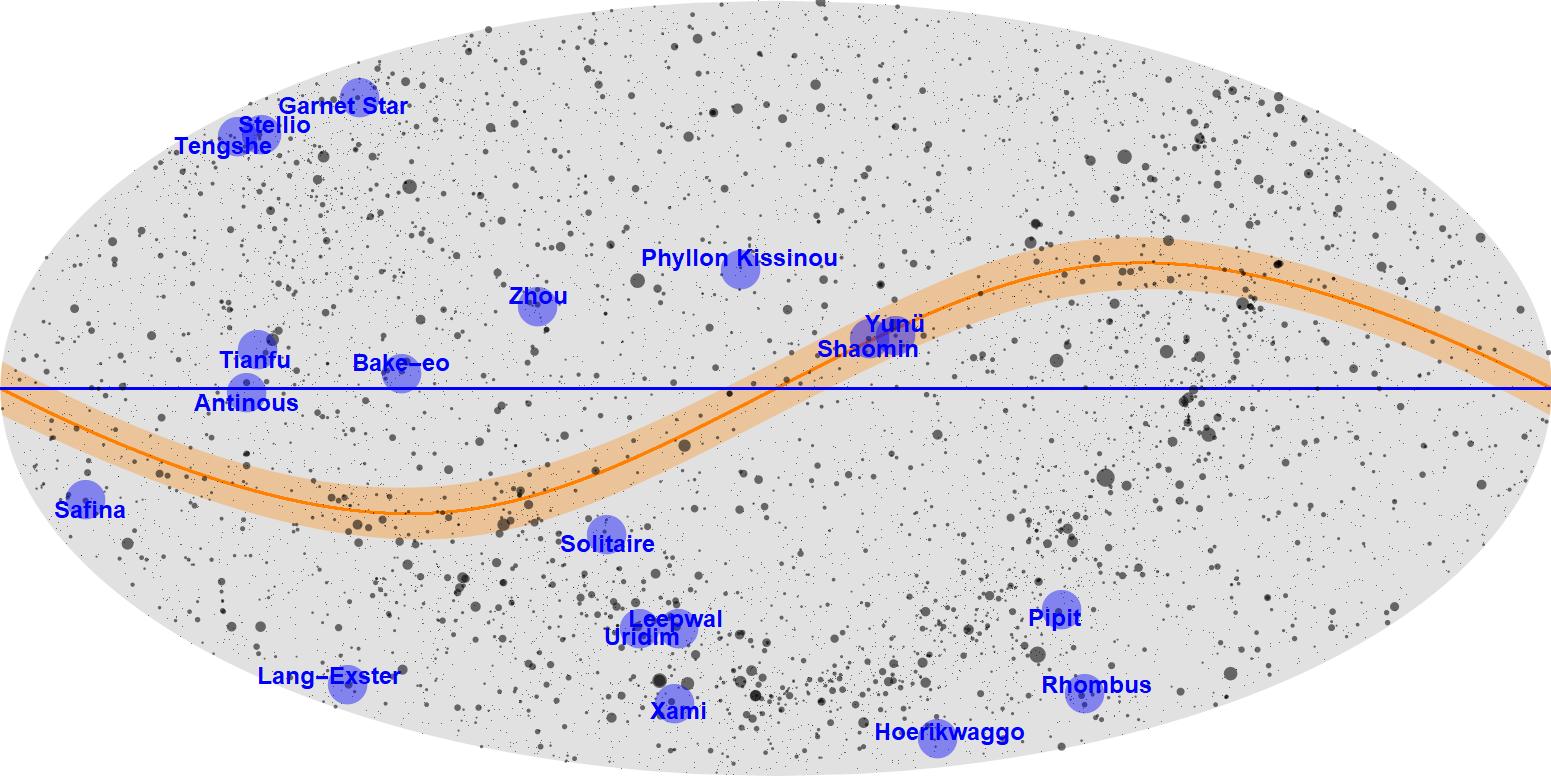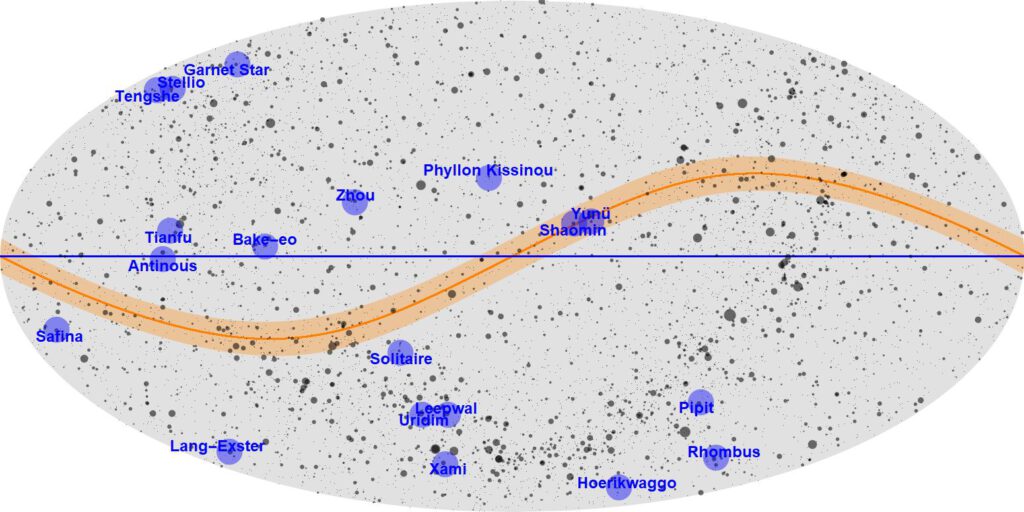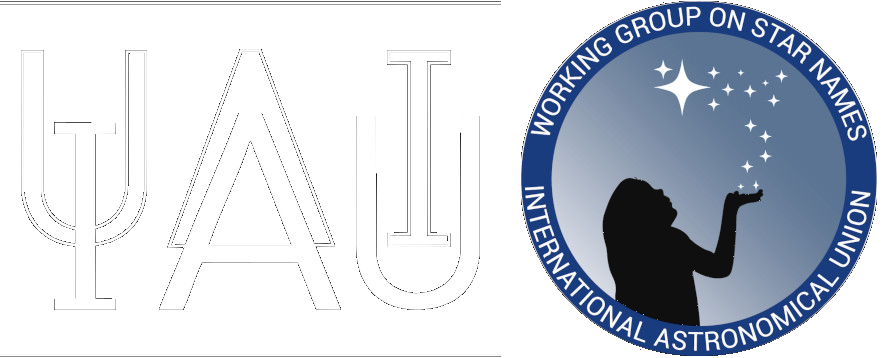New Star Names 2024

Press Release
The International Astronomical Union’s (IAU) Working Group on Star Names (WGSN) has approved 19 new proper names for stars in 2024, marking another significant step in the organization’s mission to catalogue and standardize stellar nomenclature.
These newly approved names draw from diverse cultural astronomical traditions, reflecting the IAU’s commitment to preserving humanity’s cultural astronomical heritage while establishing clear international standards for scientific reference.
Names are rigorously reviewed and cross-checked by committee members, drawing on their expertise in historical and cultural naming traditions, including significant contributions from Indigenous cultures.
The newly approved names will be added to the IAU Catalog of Star Names (IAU-CSN), which serves as the definitive international reference for adopted star names. This brings the total number of IAU-formally recognized proper names for stars to 491 since the WGSN’s establishment in 2016.
The IAU encourages the international astronomical community to use these officially adopted names in their scientific publications and communications. The newly approved names are
| Name | HIP | Constellation ID | Cultural Meaning | astrophysics | Language |
| Antinous | 99473 | θ Aql Aa | Ptolemy of Alexandria created the asterism Antinous to honour Roman emperor Hadrian’s favourite by the same name and published it in the Almagest Star Catalogue 137 CE. It is placed in the constellation of Aquila, the Eagle. | Antinous is a binary system of two evolved B-type stars that already left the main sequence: they are about to die (on the timescales of stars). | Greco-Roman |
| Bake-eo | 87108 | γ Oph | A Marshallese star name for γ Oph. Pronounced “bakey-yew”. The particle “Eo” simply means “here it is, take it”, and Bake is the spondylus mussel. The phrase “Take the spondylus mussel” used to be a name for the single star γ Oph. | A white (A0-type) star, probably with a circumstellar disc of dust at a distance of 64 AU (twice the distance of Neptune from the Sun). | Marshallese |
| Garnet Star | 107259 | µ Cep A | Piazzi (1803) named the star Garnet Sidus due to a description by W. Herschel (1773) as “deep garnet red”; the English name is well-established in recent literature and textbooks. | Garnet Star is one of the largest diameter supergiants visible to the naked eye, with a diameter about 1000x that of the Sun. | English |
| Hoerikwaggo | 29271 | α Men A | The name of the constellation originally was Mons Mensae (Table Mountain) and not only mensa (“table”); this mountain had the Indigenous name Huriǂoaxa (“Sea-Mountain”) in the Saan/ Khoe language, spelt and transliterated in Afrikaans as Hoerikwaggo. | Hoerikwaggo is a very nearby well-studied Sun-like star. | Saan / Khoekhoe |
| Leepwal | 68002 | ζ Cen A | Ļeepwal (pronounced leyepwal) is the name for ζ Cen in Marshallese. Ļeepwal was the third of the ten sons of the mother of all great stars, Lōktañūr (Capella). | Leepwal is among the brightest members of the nearest region of massive star formation: Scorpius-Centaurus. | Marshallese |
| Phyllon Kissinou | 61394 | 23 Com A | The name originates from Ptolemy’s description of the shape of the Coma Star Cluster as “φύλλοv κισσίνου (phyllon kissinou, an ivy leaf)” in the Almagest; he also calls the nebulous mass Πλόκαμος (Plokamos), the Lock (i.e. of hair), which led to the later Latin constellation name Coma Berenices. | A white (A-type) star moving closer to the Sun at a speed of 16 km/s; probably double. It’s not a member of the physical star cluster Melotte 111, although it visually appears grouped with it. | Ancient Greek |
| Pipit | 31685 | ν Pup | Among the Kendayan (Dayak Kenayatn) people of West Kalimantan province, Borneo, Indonesia, the star ν Pup is identified as “Pipit” (the Rice Thief, a sparrow). | Due to its fast rotation, this B-type (large blue) star has oblate shape with the pole radius 3/4 of the equator radius (like a grain of rice). | Dayak |
| Lang-Exster | 110130 | α Tuc A | “Lang” is a Malayan/ Indonesian term meaning “hornbill”, “Exster” is a Dutch word meaning “magpie” and both terms were used as names for the newly defined constellation in Early Modern Age by the Dutch sailors (de Houtman 1603) who artificially created the constellation as “Indian Magpie” referring to a species of bird with a strong cultural significance for the Indigenous people they met (e.g. Dayak). | The primary component of this spectroscopic binary is an evolved (orange) giant star of 2 or 3 solar masses | Malayan-Dutch |
| Rhombus | 19780 | α Ret A | Lacaille named the constellation ”Réticule Rhomboïde” which likely refers to the earlier constellation “Rhombus” that Habrecht (1621) defined in the area. | Sun-like giant star (G-type but 100 solar luminosities) that shows X-ray emissions could be a binary. | Latin |
| Safina | 114341 | 88 Aqr | An Indigenous Arabian constellation of the Ship (سَّفينة) was between Diphda and Fomalhaut (see Ibn Qutayba), for which 88 Aqr was a bright member. | An evolved red giant of K-type with high proper motion | Arabic |
| Shaomin | 51624 | ρ Leo A | Taimin太民 (or Damin大民), meaning “more bright”, for o Leo and Shaomin少民, meaning “less bright”, for ρ Leo are the two southernmost stars of the Xuanyuan轩辕 constellation (the body of the yellow dragon). They were used as star names in ancient China. | A blue supergiant (B-type) with 20 solar masses and a runaway star (peculiar velocity) situated above the Galactic plane | Chinese |
| Solitaire | 72571 | 58 Hya | An extinct constellation invented by Le Monnier (1776), Latinized “Turdus Solitarius”, was originally meant to remember the extinct bird “Rodrigues Solitaire” but was always depicted as a Blue Rock Thrush. | Solitaire is moving closer to us at a speed of 9 km/s but still 300 ly away. It’s a red giant that may become extinguished in the very far future as its mass is much smaller than the Sun’s. | French |
| Stellio | 111169 | α Lac | Hevelius invented the constellation Lacerta sive Stellio (modern Lacerta), giving it the alternative name Stellio in his star catalogue and atlas. Both Stellio and Lacerta mean “lizard”. | Stellio is a white main sequence star and one of the few stars moving closer to the Sun at a speed of -12.7 km/s (8000x as fast as a pedestrian), only 102 ly away. | Latin |
| Tengshe | 113288 | V424 Lac | Tengshe螣蛇 or 腾蛇 (Téng Shé, Flying Serpent) is a constellation created by ancient Chinese astrologers, dating back to the 2nd century BCE. | Tengshe, the ‘flying serpent,’ is also a red supergiant bigger than the Earth’s orbit. | Chinese |
| Tianfu | 98823 | Aql | Tianfu (天桴) (“celestial drumstick”) was an ancient Chinese constellation from the Wu Xian school consisting of four stars, including Aquilae. | The old drumstick is also an old star, an evolved giant star of K-type of 21 radii of the Sun that has stopped hydrogen fusion. | Chinese |
| Uridim | 71860 | α Lup | The constellation of Lupus, the Wolf, is one of the few ancient Greek constellations outside the zodiac that was directly taken over from a Babylonian constellation. The Sumerian term for the Wolf was UR.IDIM (“mad/ rabid dog”), later alternatively written “Uridimmu” in the Akkadian language (the literal Akkadian translation of UR.IDIM would be “kalbu šegû” (“rabid dog”), according to lexical lists). | Uridim is among the brightest members of the nearest region of massive star formation: Scorpius-Centaurus. | Sumerian |
| Yunü (Yunu) | 49637 | 31 Leo A | Yunü御女, meaning “palace concubines”, is the star in the middle of the southernmost stars of the Xuanyuan轩辕 constellation of ancient China. The correct transliteration is “Yunü”. | A high proper motion K-type evolved red giant, 34x the diameter of the Sun. | Chinese |
| Xami | 71908 | α Cir A | The asterism “Eyes of the Lion”, used by the San and Khoekhoe in South Africa, refers to Alpha and Beta Centauri. With these bright stars as the eyes, Alpha Circini appears in the face of the Lion (“Xami”). | An A-type star at 54 ly from the Sun that varies its brightness like alf2CVn, a chemically peculiar type of variables with strong magnetic fields. It is a member of the Beta Pictoris Moving Group. | |Xam-dialect of Khoe language |
| Zhou | 77233 | β Ser | Zhou (周) is a traditional Chinese star name for one of the stars in the historical Chinese constellation of Tianshi (Celestial Marketplace). It represents a location (in the market and a region in the country) by borrowing the name from a dynasty. | A high proper motion binary system composed of a main sequence A-type and K-type star. It is the 6th- brightest member of the Ursa Major Moving Group 153 ly away. | Chinese |
“We dug deep into the history of the constellations in order to find appropriate names for their representative stars,” said Susanne M Hoffmann, Chair of the IAU Working Group on Star Names, “Aiming to combine cultural heritage with modern global standardization and in memory of this year’s IAU GA in Cape Town, the first one in Africa and the initiation of Commission C5 “Cultural Astronomy”, we honour two main stars with Indigenous names from South Africa to diversify the sky.”
For the complete list of all approved star names and their corresponding astronomical designations, please visit our website.
More information

The IAU is the international astronomical organisation that brings together more than 12.000 active professional astronomers from more than 100 countries worldwide. Its mission is to promote and safeguard astronomy in all its aspects, including research, communication, education and development, through international cooperation. The IAU also serves as the internationally recognised authority for assigning designations to celestial bodies and their surface features. Founded in 1919, the IAU is the world’s largest professional body for astronomers.

Recent Comments